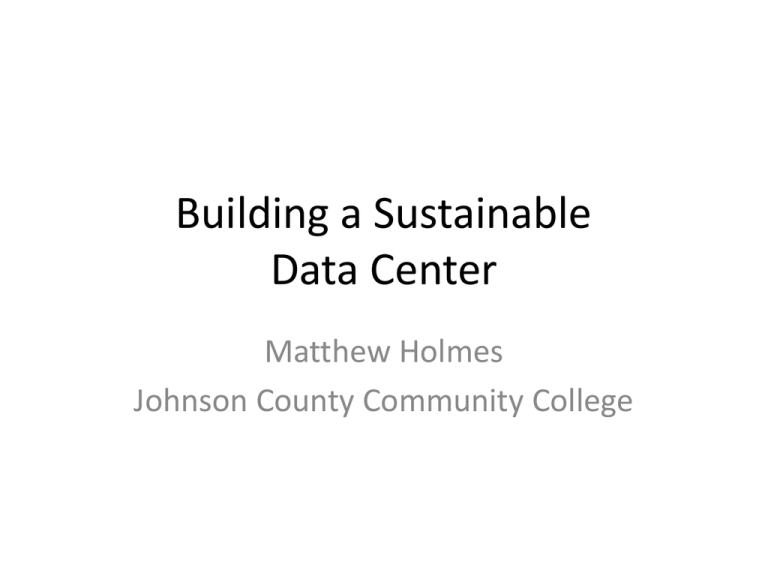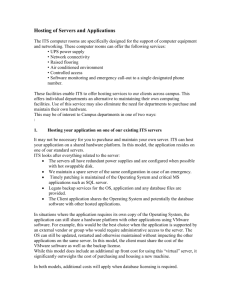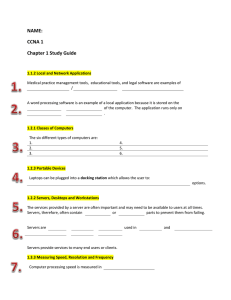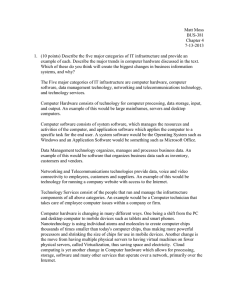Building a Sustainable Data Center
advertisement

Building a Sustainable Data Center Matthew Holmes Johnson County Community College About JCCC • With more than 39,000 students enrolled in credit and continuing education classes each semester, Johnson County Community College is the state's third largest institution of higher education and the largest of its 19 community colleges. • JCCC offers a full range of undergraduate credit courses that form the first two years of most college curricula. The college has more than 100 transfer agreements with area colleges and universities that ensure admittance to specific programs such as business, engineering and education. In addition, more than 50 one- and two-year career and certificate programs prepare students to enter the job market in high-employment fields. The college maintains extensive student support services such as computer labs, math labs, a writing center and a learning center. • The campus, centrally located in the county on 234 acres, opened in 1972. There are 20 major buildings on campus. The newest are the Regnier Center and the Nerman Museum of Contemporary Art. data center challenges • 1999 – Administrative Computing (ACS) manages three enterprise class servers hosting Banner, Oracle database, and an IVR system. • 2003 – Power and cooling in the data center is becoming an issue – Efforts are underway to house all servers in the data center – Storage Area Network is installed to consolidate storage and improve backup operations – A second power feed and UPS are added in to handle server and storage growth • 2004 – ACS manages over 50 enterprise class systems. – Windows application servers are driving growth – Standardization and best practices involve building and maintaining test systems to mirror production • 2005 – Server virtualization begins – Budget is allocated for software licensing and training – Hardware for hosting virtual machines is identified – Candidates for physical to virtual conversion are identified (test and pre-production systems are first) enterprise VM 1.0 data center 2.0 • Virtual servers help the data center do more at lower costs. Right? • Cost of supporting VM infrastructure is high – VMware license purchases and yearly maintenance – Physical servers with high CPU count and RAM are needed to support enterprise applications – Storage Area Network is consumed rapidly by VMs – Power and cooling requirements for larger servers and storage • Cost of deploying monolithic servers for applications is much higher! simple TCO calculator • Gather costs of deploying one monolithic server – Hardware Costs per physical server deployment – Power and Cooling (four years) = $5,256.00 – Hardware 2 CPU server =$10,500.00 – Deployment Cost (system administrator) = $800.00 – Procurement Cost (purchasing, accounts payable, inventory) = $400.00 – Total = $16,956.0 simple TCO calculator • Gather costs of deploying one VM host server – Costs per virtual server deployment + 15 virtual machines – Power and Cooling (four years) = $10,512.00 – Hardware 4 CPU 4 core server (one time cost for host server) = $19,800.00 – VMware License Cost (includes four year maintenance) = $8,560.00 – VM Deployment Cost (system administrator deploying 15 VMs per host) = $750.00 – Procurement Cost (purchasing, accounts payable, inventory) = $400.00 – Total = $40,022.00 power and cooling calculator • Annual Energy Cost = (8760 hrs/yr) x (utility cost $0.10/kWhr) x (Server Power in kW) x PUE – Power Usage Effectiveness, PUE of 2 assumes 1 watt of server power consumes 1 watt of chiller power • Monolithic servers running at 5% to 10% utilization consume 750 watts on average, which totals $1,314.00, annually. • A VMware host server running at 60% to 70% utilization consumes on average 1,500 watts, which totals $2,628.00 annually. the numbers $5,000,000 $4,662,900 $4,500,000 $4,000,000 $3,782,416 $3,500,000 $3,000,000 Physical Deployment $2,500,000 $2,000,000 Virtual Deployment $1,500,000 $1,000,000 $880,484 $500,000 Savings $0 TCO Comparison: Monolithic Servers vs. Virtual Data Center (four year replacement cycle) The graph shows a TCO comparison for servers, comparing 275 physical servers to 275 virtual servers running on 22 VMware vSphere Enterprise Plus host servers. Data includes power and cooling costs. power and cooling $1,600,000 $1,445,400 $1,400,000 $1,214,136 $1,200,000 $1,000,000 Monolithic Server Implementation $800,000 Virtualized Data Center Savings $600,000 $400,000 $231,264 $200,000 $0 Comparison: Cost of Power & Cooling per Year The graph displays JCCC data centers hosting 275 virtual machines on 22 VMware vSphere servers over a four year life cycle. Comparing Monolithic server implementation to the same number of servers and applications using virtualization. virtual storage thin provisioning and data de-duplication The graph shows an average of 60% storage savings using data de-duplication on SAN volumes hosting virtual machines. This data was gathered between October 2009 and August 2010 for virtual machines migrated to NetApp storage. conclusion • Server virtualization – Reduces deployment costs while increasing agility – Reduces power and cooling requirements – Can increase software licensing costs • Storage virtualization – Thin provisioning reduces VM storage footprint – Data de-duplication technology reduces storage requirements for VMs – Increases agility by leveraging SAN to move data for cloning, disaster recovery, high availability questions? • Contact information: – mholmes@jccc.edu – holmes.matt@gmail.com – twitter.com/mholmes9





